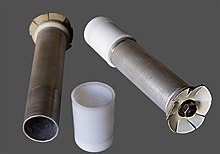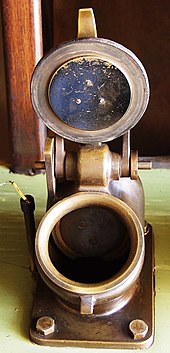Prague pneumatic post

Prague pneumatic post (Czech: Pražská potrubní pošta) is the world's last preserved municipal pneumatic post system.[1] It is an underground system of metal tubes under the wider centre of Prague, totaling about 55 km (34 miles) in length.[2] The system started service in 1889 and remained in use by the government, banks and the media until it was rendered inoperative by the August 2002 European floods.[2]
Sold on by former owner
History
The Prague pneumatic post system entered public service on 4 March 1889.[3] The first lane was constructed as early as 1887, but was used only for internal postal business at first. It ran from the main post office on Jindřišská street (next to Wenceslas Square) to the post bureau at Malé náměstí (next to Old Town Square) in Old Town. (This bureau was situated in a corner house with Linhartská street, belonging to the V. J. Rott company, next to a house that is called 'U Rotta' today.) The first lane was later extended as far as Prague Castle, making it over 5 km long. Prague was the fifth city in the world to receive a pneumatic post system after London, Vienna, Berlin, and Paris, which was considered a major achievement for Prague.[2]
The system was initially employed mainly for sending telegrams. In 1901 there were only three stations between the main Prague post office and the telegraph office.[6]
The system was established for express delivery of documents. A given document would be taken to the post office, rolled up into a metal capsule and dropped down a hatch leading to a selected location. After the clerk pressed a button, the capsule would be moved by compressed air along a network of tubes beneath the pavement.[2]
The network experienced its greatest growth in the years of economic prosperity between 1927 and 1932. In those years, new lanes were constructed and tens of thousands of capsules were transported every month. During the
In the late 1990s, the system was used by more than 20 subscribers and was operating at a loss, remaining in operation as a prestige project rather than as a business. Traffic gradually declined and the system was seriously damaged by floods in 2002, submerging 5 of 11 underground engine rooms.[7]
Pipes
The lanes consist of
The minimum
A signaling cable is laid along with the pipe, enabling communication with the track components.
The lane segments are equipped with
Transport capsule

The system uses aluminium capsules measuring 48 mm in outer-diameter and 200 mm in length. On the rear end they are fitted with a plastic circlet, preventing friction against walls of the pipe and a soft plastic skirt, sealing air behind the capsule. The diameter of the rear circlet is 57 mm. The remaining 8 mm of the bore are sealed just by the skirt, allowing for excellent airtightness and low friction at the same time.
Propulsion units


Each lane is equipped with a dedicated propulsion unit, consisting of an electrically-powered air pump. One pump can service at most 3 km of pipeline, so it's necessary to use several pumps on longer lanes.
The pumps must be
At first the pump is set to intake mode, pulling the capsule towards the tee. Before reaching it, the capsule hits the first switch, causing the pump to start reversing. Meanwhile, the capsule reaches the tee-fitting. As it passes the tee, the pump is already fully reversed and starts to push the capsule away.
The older pumps were bladed, having a single blade, mounted eccentrically inside a 300 mm high cylinder. More recent pumps employ a rotating piston instead.
Packages
The capsules can be loaded with packages up to 5 cm in diameter and 30 cm in length. Their weight can be up to 3 kg. Generally these were rolled-up telegrams, but any package within the set limits could be transported.
Dangerous and
Lanes and stations

Prague pneumatic post network consists of five main lanes arranged in a star topology, fitted with switches and concentrators, and of subscriber's lines. The total length of the lanes is about 55 km. Some of the most frequented segments have two pipes (one for each direction), but the majority of the lanes use a single pipe and the direction is determined by setting up the pumps to run in the desired direction. The main lanes connect the following post offices and bureaus:
- Jindřišská – Prague 2, Prague 3, Prague 10
- Jindřišská – Prague 1, Prague 2
- Jindřišská – Prague 5
- Jindřišská – Prague 6
- Jindřišská – Prague 7
Originally there were 16 subscriber's lines, but only 7 have been preserved to this day. A total of 24 pneumatic post stations remain today.
The network crosses the river Vltava in three spots making use of bridges (Hlávkův Bridge, Mánes Bridge, and Legion Bridge).
Headquarters/switchboard

All the lanes converge to the main post office in Jindřišská Street. Here, all the packages were carefully recorded and from here the network was controlled and monitored. This is also the place where the packages were forwarded from one lane to another. The capsule was picked up from a receiving pocket by a member of staff, recorded and inserted into the inlet of another lane.
The current lane state was indicated by indicator lights on the lane's controller. Up to 10 packages at 30-second intervals could be sent on the same lane at once, although this was rarely used in practice.
When sending capsules to switched lanes, the capsules had to be sent out in a predefined order, as the switches could only be activated before commencing the transfer. The first capsule would be diverted, after which the switch would automatically slide back to its neutral position, sending the remaining capsules in the straight direction. Therefore, the capsule that was meant to branch off had to be sent first.
References
- ^ Wertheim, Margaret. Bones to phones, New Scientist October 23, 1999; Volume 164; Issue 2209; Section: Features; Page 40
- ^ a b c d Lazarová, Daniela. Magazine 11-10-2003 Radio Prague 10 November 2003.
- ^ iDNES6 March 2007 (in Czech)
- ^ Richter, Jan (8 August 2012). "New owner promises bright future for world's largest pneumatic post system". radio.cz. Radio Praha. Retrieved 9 January 2014.
- ^ Budanovic, Nikola (22 May 2017). "The last surviving municipal pneumatic tube transport system is in Prague". www.thevintagenews.com. Retrieved 13 November 2023.
- ^ Forbes, Wentworth. (1901) House of Commons Sessional Papers. (1902) Report on the trade of the Kingdom of Bohemia for 1901
- ^ Potrubní pošta - technický unikát pod ulicemi Prahy, iDNES 17 May 2004 (in Czech)
External links
- Pneumatic Tube System in Prague
- "I Got Root on the Prague Pneumatic Post", 1999
- A Relic That Hasn't Gone Down the Tubes , Business Week 8 Oct 2001 Wayback Machinearchive
